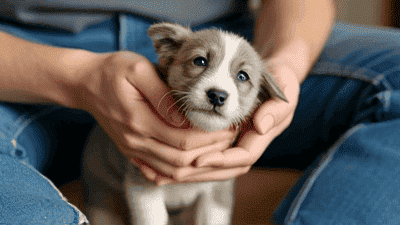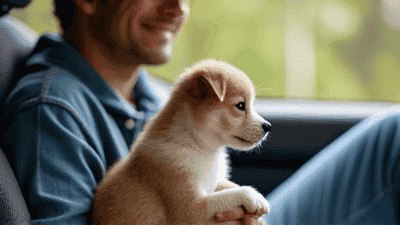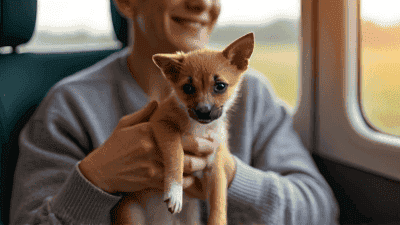
Traveling with pets can be a rewarding experience, but for many animals, the unfamiliar sights, sounds, and movements of travel can trigger anxiety. Whether you're planning a road trip, flying, or taking public transportation, managing your pet's anxiety is essential for a stress-free journey.

Gradually acclimate your pet to travel by taking them on short car rides or practice sessions in their carrier. Reward them with treats and praise to create a positive association.
If your pet will be traveling in a carrier, let them explore it beforehand. Place their favorite blanket or toy inside to make it feel safe and comfortable.
Use treats, toys, and praise to reward calm behavior during travel. This helps your pet associate travel with positive experiences.
Ensure your pet’s microchip information and ID tags are up to date. Carry a copy of their vaccination records and health certificate, especially if you’re flying.
Use a pet seatbelt, carrier, or travel crate to keep your pet safe and prevent distractions while driving.
Place a familiar blanket or bed in the car to help your pet feel at ease. Keep the temperature comfortable and avoid blasting the radio.
Stop every 1-2 hours to let your pet stretch, drink water, and relieve themselves. This helps reduce stress and prevents motion sickness.
Consider using calming sprays, pheromone diffusers, or anxiety wraps to soothe your pet during the journey.
Feed your pet 3-4 hours before the trip to reduce the risk of motion sickness. Offer small amounts of water instead.

Research airlines that prioritize pet safety and comfort. Some airlines allow pets in the cabin, while others require them to travel in the cargo hold.
Minimize stress by booking a direct flight to avoid layovers and multiple transfers.
Ensure the carrier meets airline requirements and is well-ventilated. Label it with your pet’s name, your contact information, and a "Live Animal" sticker.
Use calming aids or natural remedies like CBD oil or chamomile to help your pet relax. Consult your vet before using any supplements.
Pets can sense your anxiety, so remain calm and reassuring throughout the journey.
Review the train or bus company’s pet policy before traveling. Some services allow pets in carriers, while others have restrictions.
Place the carrier next to you and cover it with a light blanket to reduce visual stimuli and noise.
Choose shorter routes to minimize stress for your pet. If possible, avoid peak hours when the train or bus is crowded.

Products containing ingredients like melatonin, L-theanine, or valerian root can help reduce anxiety in pets. Always consult your vet before use.
Lavender or chamomile essential oils can have a calming effect. Use a diffuser or apply a diluted solution to your pet’s bedding.
These specially designed garments apply gentle pressure to your pet’s body, similar to swaddling a baby, to reduce anxiety.
Soft, calming music or white noise can mask loud sounds and help your pet relax during travel.
Gradually expose your pet to travel-related stimuli (e.g., car sounds, carrier confinement) in a controlled environment. Reward calm behavior with treats and praise.
Pair travel-related experiences with positive outcomes, such as treats or playtime, to change your pet’s emotional response.
If your pet’s anxiety is severe, consult a professional trainer or veterinary behaviorist for personalized guidance.
Pack your pet’s favorite blanket, toy, or bed to provide a sense of familiarity.
Bring calming sprays, supplements, or anxiety wraps to use during the journey.
Carry enough food and water for the trip, along with collapsible bowls for easy feeding.
Bring pet-safe wipes, a leash, and waste bags to handle accidents or messes.
Include basic first aid supplies, such as bandages, antiseptic wipes, and your vet’s contact information.
After the journey, give your pet a quiet, comfortable area to rest and decompress.
Watch for signs of stress or illness, such as lethargy, loss of appetite, or vomiting. Consult your vet if any symptoms persist.
Offer fresh water and a small meal once your pet has settled. Avoid overfeeding to prevent digestive upset.
Spend time with your pet, offering affection and reassurance to help them feel secure.
Continue taking your pet on short trips to reinforce positive travel experiences.
Stick to your pet’s regular feeding, exercise, and sleep schedule, even while traveling.
Use the same carrier, calming aids, and techniques to create a predictable and stress-free travel routine.
Traveling with an anxious pet can be challenging, but with proper preparation and care, you can help your furry companion feel calm and secure during the journey. By understanding the causes of travel anxiety, using calming techniques, and providing a comfortable environment, you can ensure a positive travel experience for both you and your pet. Remember, patience and consistency are key to helping your pet overcome their fears and enjoy the adventure of travel.